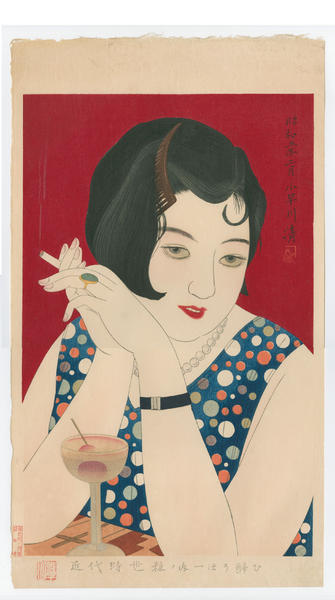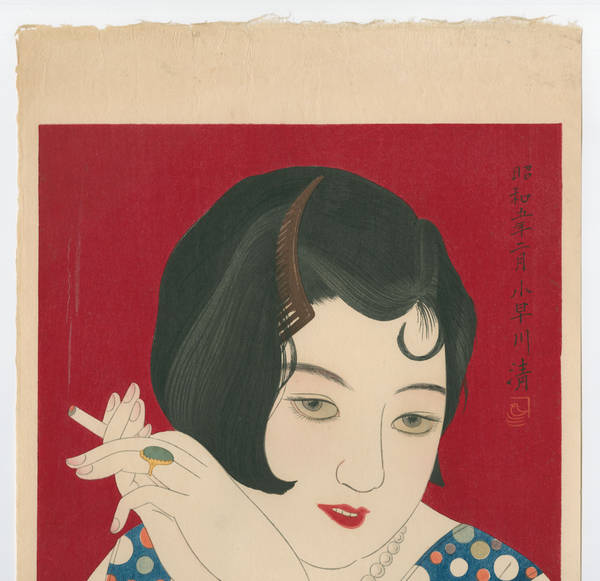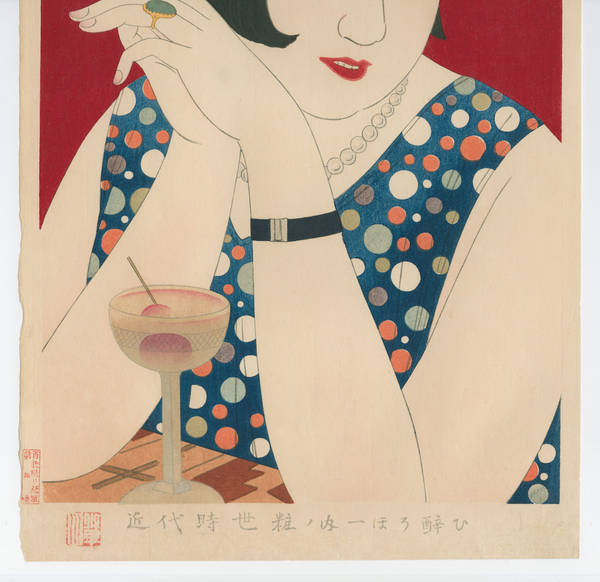| Notes (first edition)?: |
TITLE: Tipsy
Edition of 100
SERIES: Womens Manners of Today
DATE: 1930
SIZE: 19 x 12
MEDIUM: Woodblock Print
PUBLISHER: Privately published
CONDITION: Fine impression, color and condition.
Note: The series is alternatively listed in Merrit, Guide to Modern Japanese Woodblocks as: "Modern Fashionable Styles" (Kindai Jisei Sho), 1930-31. Tipsy, published in February 1930, is the first print in the series and is widely known as the best print in the series. In our opinion, Tipsy is the best print in all of the shin-hanga genre because it captures the tone of the era and is not overly sentimental.
Commenting on his own role in the genre of ukiyo-e in the March 1938 issue of Ukiyo-e Geijutsu, Kiyoshi wrote: "I copied Ukiyo-e and stuidied them, but I have found nothing to learn from them as an artist. Since only people who live in Edo could depict the atmosphere of Edo, there is no use in copying their style. In the Showa period, we have the art of Showa. Even if I try to draw a scene reminiscent of the time of Harunobu, my drawing would inevitably express the healthfull beauties of today. I do not just draw customs and manners but try to capture the essence of the time in which we live.
Kiyoshi Kobayakawa quoted by Amy Reigle, The New Wave at 177.
Ken Brown describes Kiyoshi's desire to cause social disruption with a little more color: "Here is the consummate Moga as sex object. Alone in a nightclub, she sits with her cigarette in hand and a cocktail before her, and doubtless, one already inside her. Kiyoshi cuts off the woman's elbows and most of the art deco table to let ther viewer engage her, as if in intimate conversation. The woman is thoroughly contemporary…She wears her hair cropped and curled; the barette and spit curl signal her conformity to the latest Western trends. Her pearl necklace, watchband and large cabochon ring accessorize her daring polka-dot patterned, sleveless dress. Lest we miss the point, Kiyoshi places this modern Venus against a saturated crimson background that, together with the cropped composition, sets the aggressively passionate mood even as it thrusts her nearly into the viewer's lap. Against this red ambiance, her rouged and parted lips glow like the burning tip of her cigarette, with its curl of rising smoke. Her inebriation brings a slight pink hue to the alabaster flesh of her arms; and her dilated pupils swim inside her alcohol-stained eyes like the swollen cherry in her green tinted glass".
Ken Brown, Taisho Chic, Japanese Modernity, Nostalgia and Deco, 2002 Honolulu Academy of the Arts Exhibition catalog, at p. 34
The design was featured as the cover illustration for the touring exhibition of Deco Japan, Shaping Art and Culture, 1920 - 1945. Illustrated in The New Wave at 177, fig. 220, Illustrated in Taisho Chic, ibid. |
|
| Artist Bio: |
Kobayakawa Kiyoshi is best known for designing woodblock prints of modern Japanese women. Born in Hakata, a town in the Fukuoka Province of Kyushu, Kiyoshi was one of many artists who studied with Kaburagi Kiyokata, the famous painter and print designer. Kiyoshi entered Kiyokata's school at age twenty and probably knew Kiyokata's other students including Ito Shinsui, Kawase Hasui, and Torii Kotondo. Unfortunately, little is known about Kiyoshi's life compared to those other print designers. During the 1920's and 1930's, he exhibited Nihonga (Japanese-style) paintings at several exhibitions including the Kyodokai and the Imperial Academy Exhibition. In 1923, he contributed a print design to the series, "Complete Collection of Chikamatsu". This was probably Kiyoshi's first experience designing woodblock prints. Beginning in 1930, Kiyoshi began designing a series of six bijin prints which he called "Modern Fashionable Styles" (Kindai jisei sho). These prints were carved by Tadano Shichinosuke and printed by Ono Tomisaburo. The prints in this series were (1) Tipsy, (2) Powdering the Face, (3) Pedicure, (4) Expression of Eyes, (5) Black Hair, and (6) Rouge. Though most of these prints depict Japanese women engaged in traditional feminine pursuits, Tipsy is remarkable for its frank portrayal of a modern girl, or moga. It depicts a Japanese woman dressed in fashionable Western clothing and jewelry, drinking and smoking a cigarette. Her flirtatious, blurred gaze and her flushed cheeks indicate that she is intoxicated. This print was considered quite risque when it was first published. Kiyoshi designed thirteen prints in all, twelve of which were exhibited at the 1936 Toledo Exhibition. In addition to his six self-published prints, three were published by Hasegawa, three by Ensendo (Takamizawa) and one by Watanabe Shozaburo. Kiyoshi was awarded the special rank of Tokusen for his 1933 print, The Geisha Ichimaru. He died in April 1948 at Ikegami, Tokyo. Some of his woodblocks have been reprinted since his death and have later publisher's seals in the margin. Kobayakawa Kiyoshi is best known for designing woodblock prints of modern Japanese women. Born in Hakata, a town in the Fukuoka Province of Kyushu, Kiyoshi was one of many artists who studied with Kaburagi Kiyokata, the famous painter and print designer. Kiyoshi entered Kiyokata's school at age twenty and probably knew Kiyokata's other students including Ito Shinsui, Kawase Hasui, and Torii Kotondo. Unfortunately, little is known about Kiyoshi's life compared to those other print designers. During the 1920's and 1930's, he exhibited Nihonga (Japanese-style) paintings at several exhibitions including the Kyodokai and the Imperial Academy Exhibition. In 1923, he contributed a print design to the series, "Complete Collection of Chikamatsu". This was probably Kiyoshi's first experience designing woodblock prints. Beginning in 1930, Kiyoshi began designing a series of six bijin prints which he called "Modern Fashionable Styles" (Kindai jisei sho). These prints were carved by Tadano Shichinosuke and printed by Ono Tomisaburo. The prints in this series were (1) Tipsy, (2) Powdering the Face, (3) Pedicure, (4) Expression of Eyes, (5) Black Hair, and (6) Rouge. Though most of these prints depict Japanese women engaged in traditional feminine pursuits, Tipsy is remarkable for its frank portrayal of a modern girl, or moga. It depicts a Japanese woman dressed in fashionable Western clothing and jewelry, drinking and smoking a cigarette. Her flirtatious, blurred gaze and her flushed cheeks indicate that she is intoxicated. This print was considered quite risque when it was first published. Kiyoshi designed thirteen prints in all, twelve of which were exhibited at the 1936 Toledo Exhibition. In addition to his six self-published prints, three were published by Hasegawa, three by Ensendo (Takamizawa) and one by Watanabe Shozaburo. Kiyoshi was awarded the special rank of Tokusen for his 1933 print, The Geisha Ichimaru. He died in April 1948 at Ikegami, Tokyo. Some of his woodblocks have been reprinted since his death and have later publisher's seals in the margin.
|
|








